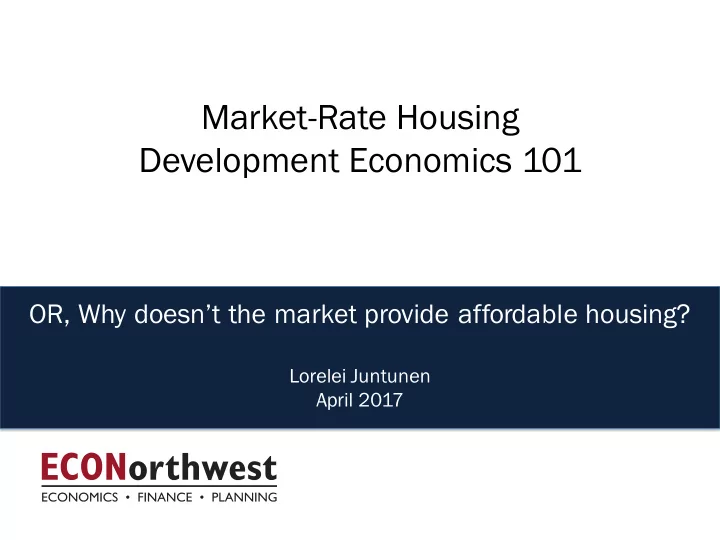

Market-Rate Housing Development Economics 101 OR, Why doesn’t the market provide affordable housing? Lorelei Juntunen April 2017
Affordability Spectrum Private tely-fund nded and nd Publicly ly-fund nded and nd / or produced produc uced Primarily 80% MFI ++ Primarily 0 – 30% MFI Federal programs Community LIHTC Regulatory Public Private (HOME, CDBG, etc.) Land Trusts Projects Property Inclusionary zoning General fund Tax Non-profit- Supply-side strategies Abatement funded projects Housing bond Land (i.e., increase allowable Donations density in SF zones) Linkage or impact fees Ince centi tive-base sed Incentive zoning Transfer of Development Rights Development Finance Land Write-Downs
Part 1: The Theory
The Concept of Housing Filtering: “Naturally Occurring” Affordable Housing
Price Supply Equilibrium Price Affordability Gap Subsidy Affordability at 60% MFI Demand Quantity Equilibrium Quantity
Price Supply Equilibrium Price Affordability Gap Subsidy Affordability at 60% MFI Demand Quantity Equilibrium Quantity
Part II: The Theory Plays Out in Portland
Housing Permits per New Portland Resident
Single Family Affordability (5% Down Payment, 2016) Slide or two about affordability for rent and for sale product in PDX
Renter Affordability (1 BR) Portland Gresham +70% +106% $1,400 Increase from 2000 $1,268 $1,300 $1,200 $1,100 100% MFI Average Monthly Rent $1,000 $964 $900 $800 $700 60% MFI $600 $500 $400 2000 2001 2002 2003 2004 2005 2006 2007 2008 2009 2010 2011 2012 2013 2014 2015 2016
Part III: Why don’t developers just build more units?
Project Operating Pro Forma Apartment Rent Parking Retail Revenues Operations Vacancy Costs and Debt Service Expenses Property Tax Reserves Net Cash Returns Flow
Net Cash Flow Distributions (“Waterfall”) Internal Rate Equity Developer of Return % 25 18 75% % Underwriting 15 Target 60% 40% 12 8 Third Return Initial Return Second Return Tranche Tranche Tranche
Leverage Points: Land and Policy Public Policy Development Market Land Can Occur Feasibility Rent and Construction Cost Fixed Capital Capital is mobile
Making Housing Affordable Supportive public policy Available subsidy programs for below- market development Creative partnerships to: Reduce development costs Secure available land
Email: juntunen@econw.com
Recommend
More recommend